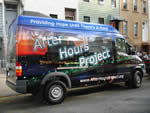
The Solution
What
is already established in Brooklyn:

The Syringe Exchange Program
_________________________________________________________
Brooklyn
experiences a similar situation as Baltimore, Maryland in 2000. Like Baltimore,
Brooklyn also experiences a high HIV/AIDS rate through the injection of drugs in
African Americans. In the Bardach’s study in 2000, he suggests African
Americans who are affected by poverty, crime rates, and substance abuse is most
likely to be the injection drug users. He recommends that the injection drug
user situation should be addressed within affected nearby neighborhoods that are
high at risk for transmission of HIV (2 & 5). Two years later in Brooklyn,
Fernando Soto and Richard Curtis creates a program called the After Hours
Project that targets the high-risk neighborhoods in Brooklyn, such as Bushwick,
in which 1 in 20 people are infected with HIV or AIDS. Since 2002, the mobile
van of the After Hours Project is driven for three nights a week, and free
sterile syringes and condoms were given out to people in hopes of preventing any
more people contracting the disease (3). It also provides free HIV testing,
one-on-one HIV counseling, and harm reduction and education programs. This
project continues to service the areas that are have an overall of low income
and are dominated in minorities. It serves the areas of Crown Heights, Bedford
Stuyvesant, East New York, and even Ridgewood, Queens, in hope of reducing
injection drug transmissions. It is currently funded by the New York State
Department of Health and the Medical Health Research Association (http://www.afterhoursproject.org/needleexchange.html).
After Hours Project: Front Door-
located on 1232 Broadway
Brooklyn, New York 11221

Inside the After Hours Project Office

Mobile vans patrols around
Crown Heights and Bedford Stuyvesant



Inside the van

All photos are credited to
After Hours
Project
Another syringe exchange program is the Expanded Syringe Access
Demonstration (ESAP) issued by the New York State. This program allows
pharmacies to sell syringes without prescriptions to allow easier access. As a
result, there was a general positive feedback from the public where there is an
increase in pharmacy syringe use and a decrease in reusing syringes. This is
especially true in the black race in New York City. This ESAP program was
generally agreed that it is an efficient and most effective way to induce
individual change among drug users (4).
As described by Heller in 2004, drug users living in New York City
who are minorities are usually “living unstably, lacking of health care, long
wait lines, lack of transportation, lack of information, discrimination, and
disrespectful staff.” The only way to address the drug user problem is to
formulate “partnerships between community-based harm reduction organizations”
and to find medical workers who are willing to collaborate with them (5). One
example is the partnership between the organization CitiWide Harm Reduction
Inc., and the Montefiore Medical Center in the Bronx. Together, this partnership
created a harm reduction program that helps to provide services such as
prevention and harm reduction education, housing placement, and mental health
care.
In devising a program that targets the black race in Brooklyn, I
decided to expand on the services that the After Hours Project offers. The
After Hours Project already contains a very comprehensive program in targeting
drug users in the highest risk neighborhood, which includes programs such as
intakes and assessments on specific individual HIV cases, syringe exchange and
Expanded Syringe Access Program (ESAP), outreach to injectors and other
high-risk drug users through mobile vans, harm reduction and one-on-one
counseling, education on prevention and safer injection practices, general
condom education and distribution, supportive services, and referrals from and
to clinics (http://afterhoursproject.org/programs.html).
Therefore I decided to focus on
the areas that the After Hours Project did not touch upon on, which was
specifically focusing on the homeless black adolescents in Brooklyn. I spoke to
a representative from the After Hours Project, unfortunately I was unable to
receive the nonprofit annual financial reports because I was not one of their
funders. However, syringe exchange programs in New York City since 1995 on the
average cost $588.00 per week, or $30,000 per year in serving the public 147
hours per week (13). Due to and 15% inflation over the past years, the cost
average syringe exchange today would cost about $823.14 per week, or $41,997.03
annually (http://www.halfhill.com/inflation.html).
>>Continue
onto the Teen Health
Empowerment Project
<<back